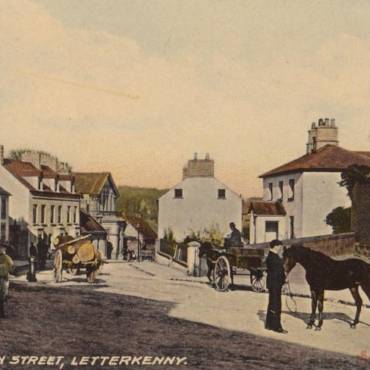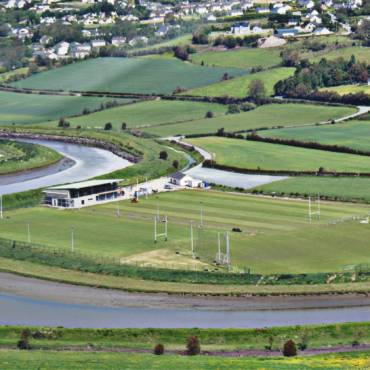ON THIS DAY: 23rd September 704: THE DEATH OF SAINT EUNAN
Today marks the feast day of Saint Eunan, marking the anniversary of his death in 704. The Cathedral that dominates the skyline, the College, the GAA Club, the Bishop’s Palace and the terrace of houses all share the name of St. Eunan and, as such, the saint is very much synomonous with the town of Letterkenny today.
However, many might be surprised to learn that St. Eunan actually has absolutely nothing to do with the town at all, or even the earlier territory of Leitir Ceanainn. He is actually associated with the much older settlement of Ráth Bóth (Raphoe) and he only came to be associated with Letterkenny when the Roman Catholic Bishop of Raphoe changed his official residence in the late eighteenth century. Put simply, when Bishop Anthony Coyle took up residence in the parish of Conwal in 1782, he brought the saint’s name with him to the area. Eunan’s connection is with the whole Diocese of Raphoe, which originated and takes its name from the historical settlement of Ráth Both but whose centre today is very much the town of Letterkenny, owing to the residency of the Bishop.
St. Eunan was born around 627 at Druim Thuama (Drumholm near Rossnowlagh). His father was Ronan, son of Tinne who was a son of Colmán mac Sétna, a cousin of Saint Colmcille thus creating a link between the two saints. His mother was Ronat, daughter of Ségéne of the Cinéal nÉnnaí race whose territory bordered Ráth Both.
Today, he is referred to as St. Eunan but in the earlier manuscripts and annals, he is referred to as Adoman, most likely a monastic name coming from A’doman meaning a ‘man of great dread’ . By the tenth century, the spelling changed to Adaman, which became Adhnaimnáín, later anglicised to Eunan.
It is thought that he studied for the monastic life at Druim Thuama before continuing his education at the esteemed school of Clonard although we do not know much of his life prior to attaining the position of Abbot of Iona in his mid fifties. Upon his death, Colmcille had been succeeded as Abbot of Iona first by Baithin (597-598), followed successively by Laisrén (598-605), Virgno (605-623), Segéne (623-652), Suibne (652-657), Cummene (657-669), Failbe (669-679) and eventually Adoman (679-704).
The importance and influence of Eunan is marked by four key events in his life. The first took place while he held the position of the highly respected abbacy of Iona. Eunan had a friendship with Aldfrid, the King of Northumbria; a relationship that greatly assisted the abbot in gaining the freedom of sixty Irish captives in 686, who had been captured in a Northumbrian raid two years previously.
Another of his achievements is when Eunan transcribed the pilgrim Arculf’s travels of the Holy Land, known as De Loctis Sanctis, or “Concerning the Holy Places” giving the modern historian an invaluable descriptive picture of the Middle East in the seventh century. This important piece of literature was incorporated by Bede into his Historia Ecclesiastica and is preserved in Berne and Paris today.
However, his Vitae Sancti Columbae is arguably his most lasting literary accomplishment, composed sometime between the years 688 and 692. It is the oldest surviving document concerning the life of Colmcille and remains one of the most influential manuscripts of early Christian literature.
Amusingly, the Vita Sancti Columbae contains a story that has been interpreted as the first reference to the Loch Ness Monster.
“Also at another time, when the blessed man was for a number of days in the province of the Picts, he had to cross the river Nes [Ness]. When he reached its bank, he saw a poor fellow being buried by other inhabitants; and the buriers said that, while swimming not long before, he had been seized and most savagely bitten by a water beast…”
Perhaps one of Eunan’s most lasting and important achievements took place in 697 at the Synod of Birr. Amongst a gathering of Irish, Dal Ríadan and Pictish nobles, he promulgated the Cáin Adamnáin, or the “Canons of Eunan”. It was a set of laws designed to guarantee the safety of women, children and clerics in warfare. For this reason it is also known as the Lex Innocentium or “Law of Innocents”. It is the earliest example of a law protecting non-combatants recorded in Europe, and as such is often regarded as having a major influence on the Geneva Convention and the Universal Declaration of Human Rights.
Eunan died on the 23rd September 704 at Iona, the date still preserved as his feast day. Although primarily associated with the whole Diocese of Raphoe, when a residence was built for Bishop Coyle on the Ballymacool estate of Samuel Span in the late eighteenth century, Saint Eunan ‘arrived’ in the town of Letterkenny and established a connection that is still evident to this day.



